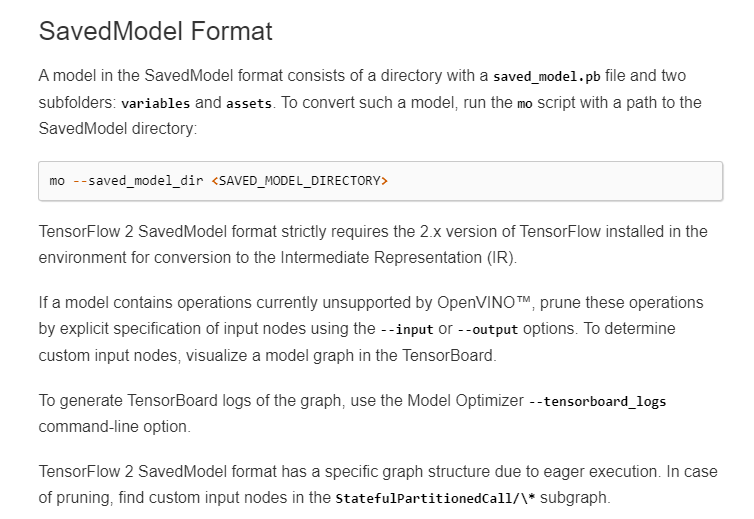First, I have all the tools currently available to convert models between mainstream frameworks.
- https://github.com/onnx/tensorflow-onnx (ONNX official tool, Insufficient optimization)
- https://github.com/PINTO0309/onnx2tf
- https://github.com/PINTO0309/tflite2tensorflow
- https://github.com/PINTO0309/openvino2tensorflow
Since each tool has its own characteristics, it is difficult to say that this tool is the best, but tensorflow-onnx or tflite2tensorflow is probably the most suitable for your application.
Your model contains a special OP TFLite_Detection_PostProcess. This is a very special OP that can only be interpreted by the TensorFlow Lite runtime. I expect that your model was generated using the TensorFlow Object Detection API or something similar.

Therefore, it is necessary to replace this special OP with a general OP and then perform a conversion that optimizes it for OpenVINO and Myriad. tflite2tensorflow and openvino2tensorflow have that capability. As a result of continued enhancements without regard to the name of the tool, a single tool is able to convert models between multiple frameworks.
First, I rarely use saved_model. I use the tfltie model instead. This is because the structure of the model is determined to be in a nicely optimized state. tensorflow-onnx does not optimize the model well enough.
https://github.com/PINTO0309/tflite2tensorflow
xhost +local: && \
docker run --gpus all -it --rm \
-v `pwd`:/home/user/workdir \
-v /tmp/.X11-unix/:/tmp/.X11-unix:rw \
--device /dev/video0:/dev/video0:mwr \
--net=host \
-e XDG_RUNTIME_DIR=$XDG_RUNTIME_DIR \
-e DISPLAY=$DISPLAY \
--privileged \
ghcr.io/pinto0309/tflite2tensorflow:latest
tflite2tensorflow \
--model_path trained.tflite \
--flatc_path ../flatc \
--schema_path ../schema.fbs \
--output_pb \
--optimizing_for_openvino_and_myriad
tflite2tensorflow \
--model_path trained.tflite \
--flatc_path ../flatc \
--schema_path ../schema.fbs \
--output_no_quant_float32_tflite \
--output_onnx \
--onnx_opset 11 \
--output_openvino_and_myriad




or

or
http://blobconverter.luxonis.com/

We can see that the level of optimization of the model's structure is different from other tools.


Issue Type
Support
OS
Windows, Other
OS architecture
armv7, armv6
Programming Language
Python
Framework
TensorFlow
Model name and Weights/Checkpoints URL
This is a custom trained model on edgeimpulse.com which provides a Tensorflow SavedModel as well as a Tensorflow Lite Model at the end of the training. The issue is converting a Tensorflow SavedModel to a Luxonis Blob model by first Freezing the Tensorflow Saved Model and then trying to use https://blobconverter.luxonis.com/.
Description
These are my files: SavedModel file: SavedModel.zip
Tflite file: Tflite_file.zip
Sorry for opening this issue since this is beyond the work you do but since I saw your work on the Luxonis discord on helping convert Tensorflow SavedModels to Luxonis Blob format, I just wanted to reach out as a last resort. I've tried many different alternatives:
1) Freezing a Tensorflow Saved Model. The method successfully freezes the SavedModel, however it fails while using https://blobconverter.luxonis.com/ to convert the Frozen format to a blob format.
Code to freeze the SavedModel:
Error I get with blobconverter:
2) Using a SavedModel -> IR Representation (OpenVINO) -> Blob conversion I used the standard OpenVINO instructions on the site to convert the SavedModel into a .xml and a .bin file.
This is apparently what I used and it converted it successfully to .xml and .bin files, however the .xml file was just 2 Kb and the .bin file was 0 Kb Output while conversion:
Nevertheless, I tried to convert to a blob file and it converted it to a 1Kb file and when I tried to run it, the NN size was displayed to be 3x320 which was absurd since it was trained on 320x320 images [1,320,320,3] format.
I reran the conversion again using:
However, this time when I converted it to blob and used it while running, it gave me an error stating the bounding boxes contain x=1,y=0,w=0,h=0.
3) This time I tried a .tflite to .onnx approach using https://github.com/zhenhuaw-me/tflite2onnx which wasn't successful in converting it to onnx in the first stage itself. ( A .tflite model is also included on the EdgeImpulse dashboard so I thought of trying this out)
Code:
Error:
Next, I tried using tf2onnx (https://github.com/onnx/tensorflow-onnx) using a SavedModel file Input:
Output:
But after that, while converting it to blob using blobconverter, this is the issue:
I'm completely stuck and have tried everything I could and hoping there is some workaround. Thanks a lot for your open-source contributions! Any workaround on converting this to blob would be really helpful since I'm completing the project under a narrow time constraint.
Thanks! Dhruv Sheth
Relevant Log Output
No response
URL or source code for simple inference testing code
SavedModel file: SavedModel.zip
Tflite file: Tflite_file.zip